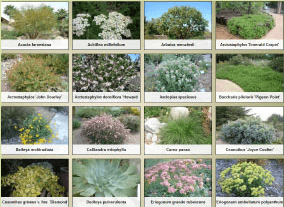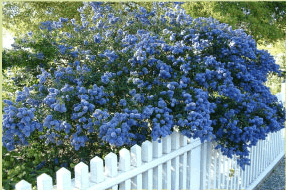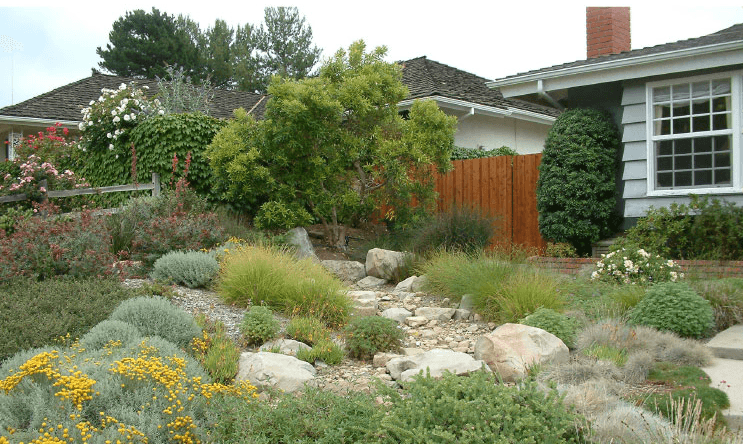If you plant a shade plant in full sun, it will require a huge amount of water to survive, if it will survive at all. If you plant a sun plant in the shade, it will be spindly and weak. You will need to water groups of plants together on the same irrigation valve. You do not want to place heavy water-needing plants with those that need very little.
Putting the right plants in the right places in the right groupings is both the challenge and art of good landscape design. Many plants adapted to Mediterranean climates will also thrive locally with our cool, wet winters and dry summers. Pesticides and fertilizers are not needed, protecting the environment and your health and saving you time and money.
Diverse plantings limit the spread of diseases by creating buffers between susceptible plants, attract beneficial insects to control pests, flower successively through much of the year and may also offer food and shelter to wildlife.



Plant Placement
A plant may be in the wrong place if it does not thrive, outgrows its space, or is prone to diseases and insect pests. The best solution is to replace the plant with one better suited to the site.
Don’t be alarmed if you make a mistake. Mistakes are a natural part of gardening. In some ways, ornamental landscape design is really just a big experimental process with Mother Nature holding all the secrets.
Do your best to match the sun, soil and water requirements of a particular site with those of the plants. If the plant falters, don’t be afraid to try and transplant it to another part of the garden for experiment number two.
Sun, Soil, and Water Requirements
The key to getting the right plant in the right place has to do with matching the sun, soil and water conditions a plant needs, to the home environment you have. There are many micro-climates around your home.
There are places protected from the sun by your home or walls. There are places where your soil is richer than in other places (think raised planters with all new soil) and there are places where water is more available than in other places (the edge of lawn areas that get irrigated more frequently than other areas of the garden, for example).
Most plants at nurseries will post the sun, soil and water requirements of a plant on the label. If not, here is one helpful hint. At the nursery, the shade plants are put under cover of some sort and the sun plants are out in the open.
The best thing to do is talk to the nursery professional about what it is you need, and where to plant what you like.
Hydrozoning
Try to put plants together that have the same water needs. This is called hydrozoning. Since you have to divide your irrigation system into zones it is best to group plants according to their water needs.
If you have just one high water-needing plant mixed in with low water-needing ones, you are forced to water everything more than the majority of plants need. This leads to water wastage. Check the nursery labels for water requirements.
You can look up the plants by name on this web site to discover their hydrozone. Collect plants into your private list and use the hydrozone report to divide them for you.
The Advantage of California Native and Mediterranean Climate Plants
California Natives and Mediterranean plants are by design, acclimated to weather patterns that provide water in only one season out of four. Plants from temperate climates are designed to receive water throughout the year. This leads to lots of extra irrigation. There are many great new native plants that are finding their way into the nursery industry. Some nurseries have a special section for them set aside. Mediterranean Climate plants come all of those places around the world that share California’s weather patterns.
Ask your nursery professional about these types of plants the next time you go plant shopping. Some of the advantages include:
- Natives thrive in the local soil and climate, and resist local diseases and pests.
- Local birds, butterflies, and pollinators are adapted to live with and benefit from them.
- Enhances a sense of place by using California’s unique flora

- Require much less water than other plants once established
Consult a garden designer or nursery professional to help you choose the right plants.

General Planting Tips
Plant with the Rain
In California planting in the Fall months of October to December will provide the advantage of cooler temperatures and the advent of seasonal rain storms.
These conditions allow the plants to set down roots before they have to face the hotter temperatures of summer and lack of precipitation Studies show that plants grow more vigorously with ionized rain water.
Soil Preparation
Most California soils are heavy, clay soils. Mixing one to two inches of good quality compost into the soil will improve drainage, prevent crown rot, and help plants establish successfully.
Planting on small mounds or in raised beds can also improve drainage and add interest to the landscape.
Digging the Planting Hole
The planting hole should be as deep and about twice as wide as the root ball. This will allow feeder roots to grow out horizontally in the compost-amended soil.
Carefully remove the plant from its pot and gently loosen the roots. Hold the plant in the center of the hole and fill in with excavated soil. Make sure that the root crown (where the stem meets the roots) is level or slightly above the soil surface.
Since you are adding the volume of a new plant with its root ball, you are sure to have extra soil after planting.
Take the excess soil and build a basin around the plant. This will help funnel water into the newly planted root ball. Over time, this basin will breakdown and be covered by a blanket of mulch.